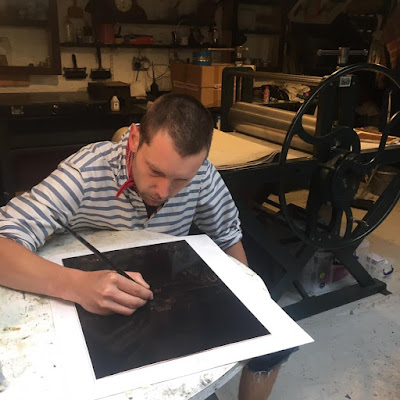The Drawing Year Student Story, Jack Fawdry Tatham from Royal Drawing School on Vimeo.
_____
Pollock Toy Museum owner and curator, Jack Fawdry Tatham continues his family's tradition of printmaking. Right now, Jack is working on a commissioned bespoke toy theatre for the Museum of Witchcraft and Magic in Boscastle.
BELOW: Some images of Jack’s process for designing a Toy Theatre from scratch. First he draws it out and then scratches the design into copper plates to be etched using acid. To see more of Jack’s etchings visit his website.
ABOVE: Tangled trees scene to be used as a backdrop for the toy theatre scratched onto the metal with some traditional toy theatre backdrops behind in colour.
BELOW: The next stages of the printmaking process for the toy theatre we're making for the Museum of Witchcraft and Magic in Boscastle! Above, you were shown pictures of Jack's preliminary sketches and "scratching" into metal and "dipping into acid" was mentioned. But what do we mean by this?
- These pictures show how Jack has scratched his design into a wax “ground”. This ground is rolled onto the metal plate whilst the metal is warm and then "smoked" so it turns black using wax tapers. "Smoking the plate" is a pretty witchy process if I ever did see one. See pic of Jack holding aloft the flames to the metal!
- When the "ground" is blackened you are ready to scratch into it using fine-pointed tools to draw the design. This exposes fine lines of the metal. In the picture you can see the shiny lines catching the light!
- The plate is then dropped in acid which "bites" into the exposed metal creating grooves. These grooves are what the ink then squishes into but more on this part of the process in the next post...
Smoking the plate with wax tapers to get the ground a deep black colour!

When making printing plates, you have to learn how to write backwards!
See how the copper shines through where Jack has
scratched away. Look at this Macbeth inspired coven!
Next, an acid bath is used for etching designs on copper plate.
Now, the printing plate is ready to be inked. Scrim, ink and an oil can full of vegetable oil are at the ready. Using the scrim, the ink is carefully applied over the plate, pushing the ink down into the etched grooves, to prepare for the printing process - "...the scrim is used to push the ink into the grooves using a pushing and twisting motion. Then you use cleaner bits of scrim to take excess ink off. It’s quite a nifty technique where you have to move the hand in a certain way so you don’t take or leave too much ink!"
Next, the final prep prior to printing.
- First Jack bathes the paper in a water bath. This relaxes the fibres of the paper making it easier for the ink from the copper plate to bed into it. The paper isn't soaking though, excess water is pressed out of the paper by placing it between sheets of thicker paper to soak up unwanted moisture;
- Then Jack sets up the press. The "blankets" you see in the picture are used to create cushioning between the press' roller and the copper plate and to help keep everything protected and snug;
- Jack now places the copper plate on the table of the press and registers his paper over the top. Then the blankets come down as the final layer before printing get rolling!
Soaking the paper in the water bath
Placing the paper over the plate
Straightening the blankets over the top, ready to roll through
Pressing the print
Final Product: The Print!
ABOVE: Artist/Printmaker Jack Fawdry Tatham, son























